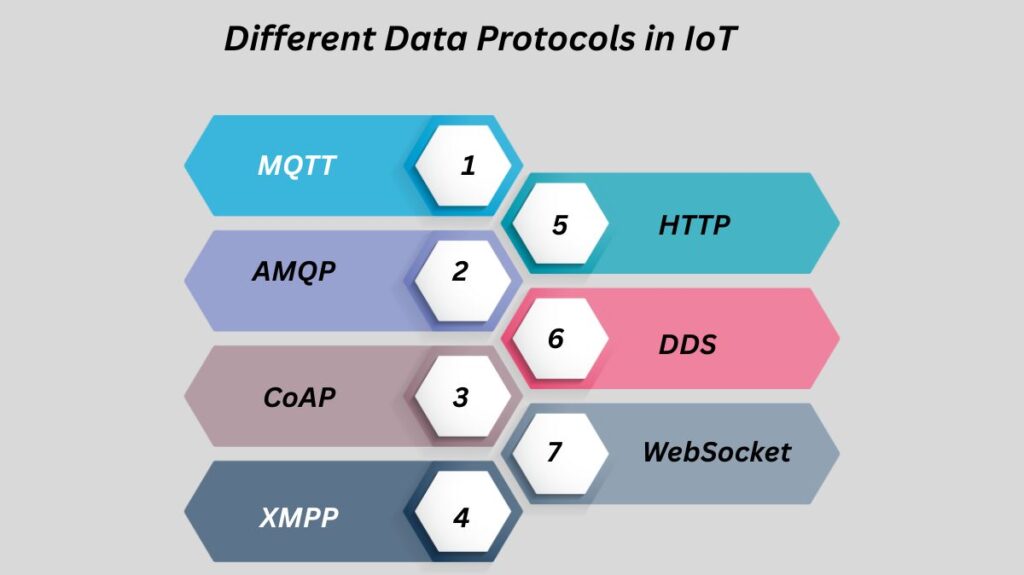Data Protocols In IoT enable secure and efficient communication between devices. Learn about MQTT, CoAP, HTTP, and more in IoT networks.
The significance of IoT protocols and standards is overlooked in common misconceptions about the Internet of Things. These data transmission protocols are not dependent on the Internet and function at low OSI layers. IoT data standards facilitate communication between low-power Internet of Things devices. The majority of firms prioritise communication in one way or another. Device, IoT sensor, gateway, server, and user app communication would all be compromised in the absence of appropriate IoT protocols. Connectivity in IoT data protocols is made possible via wires and cellular data networks.
Importance of IoT protocols
Users can control gadgets using commands and information. IoT protocols, a key component of the IoT technology stack, enable network node information sharing. The hardware would be utterly useless without established protocols for the Internet of Things. At the following node in the chain, it ensures that data sent by sensors or other endpoint devices is correctly received and processed. This is due to the fact that IoT protocols enable all of these devices to communicate with one another and exchange data and commands.
Different Data Protocols in IoT

The Internet of Things uses a variety of data protocols, which are briefly explained below.
MQTT (Message Queuing Telemetry Transport)
Despite operating in contexts with limited bandwidth, MQTT is a lightweight protocol that allows communication between nodes in both dependable and unreliable networks. A publisher-subscriber messaging mechanism makes it simple for different hardware nodes to share information. Data standards for the Internet of Things were created to address unstable connectivity. The main selling point of MQTT is its design. It uses less energy to operate devices because of its light and basic genetic composition. It functions on an existing network layer, just as TCP/IP. Even though MQTT is a widely used Internet of Things protocol with industrial applications, it lacks a defined data representation or device management structure mode.
Because it allows for remote device monitoring and gathers data from a variety of electrical devices, MQTT is a popular protocol for Internet of Things devices. Furthermore, since the protocol lacks built-in security, security needs to be managed at the device and/or application levels. The most common applications for MQTT are in low-cost, low-memory, low-power devices.
AMQP (Advanced Message Queuing Protocol)
AMQP is a software layer protocol that provides queuing and routing in a message-oriented middleware environment. However, it is not widely accepted in other settings. In contrast to the Internet of Things, AMQP was initially created for use in financial organisations. Low-powered IoT sensors cannot use AMQP because it requires too many resources. The AMQP protocol is most commonly used in the banking industry.
These are a few of the main applications for this Internet of Things protocol.
- Making a link between these components
- Getting incoming messages in queue
- Staying in contact with other people
The dependable transmission and storage of communications is facilitated by all three of these elements.
CoAP (Constrained Application Protocol)
This strategy will be advantageous for Internet of Things systems that use the HTTP protocol. IoT devices can leverage the internet infrastructure, but it’s often too resource-intensive and difficult. Like HTTP, it is client-server and supports the REST architecture, allowing clients to send GET, POST, PUT, and DELETE requests to URL-accessible servers.
By modifying the HTTP model for use in limited devices and networks, CoAP, on the other hand, gets over this restriction. Delivery cannot be guaranteed because of the unstable UDP nature of the one-to-one connections that CoAP uses. Numerous automated systems, mobile devices, and microcontrollers use the CoAP protocol. It can be easily constructed, offers multicast capabilities, and has very low overhead.
XMPP (Message Protocol and Presence Expansion)
XMPP is flexible and can readily adjust to changing conditions. One of XMPP’s unique characteristics is the way it addresses and identifies nodes. XMPP is an easy-to-use protocol that is freely accessible to the general population. Similar to an email address, XMPP gives every device a unique identification. The extensible markup language (XML) was used to create XMPP, a presence indicator that indicates whether servers or devices are present for sending or receiving messages.
Because XMPP is a reasonably flexible data transfer protocol, it is the foundation of some instant messaging apps, such as Google Hangouts and Messenger. Inter-device communication can then be reliable and safe.
HTTP (HyperText Transfer Protocol)
A brief reference to the HTTP model has already been made. The Hypertext Transfer Protocol (HTTP) was created to allow data transfer between computers (servers). Users can use this program to print three-dimensional objects from any computer that is connected to a networked 3-D printer.
However, because to the amount of data it makes available, the HTTP protocol is crucial in many industries, such as 3-D printing and manufacturing. The World Wide Web (WWW) data interchange was made easier with the development of this protocol. Therefore, it makes sense to use it in the Internet of Things.
DDS (Data Distribution Service)
Similar to MQTT, DDS uses a publish-subscribe strategy; the main distinction is that brokers are not used. DDS offers high-quality IoT communication, just like other scalable IoT protocols. It may be used on small devices and on the cloud.
Temperature sensors and smartphones are “publisher” and “subscriber” here. DDS permits data exchange across platforms, hardware, and operating systems, unlike MQTT. To get rid of bottlenecks, a technology called Global Data Space (GDS) connects every node to every other node. Many consider DDS to be the first open worldwide middleware standard for the Internet of Things.
WebSocket
An improvement on the HTTP connection is WebSocket. In an Internet of Things network, WebSocket can be used to allow nodes to communicate with each other continuously. Similar to CoAp, WebSocket employs a standardised connectivity protocol that facilitates two-way Internet communication and connection management. As a result, entities assuming the roles of client or server usually employ it.
